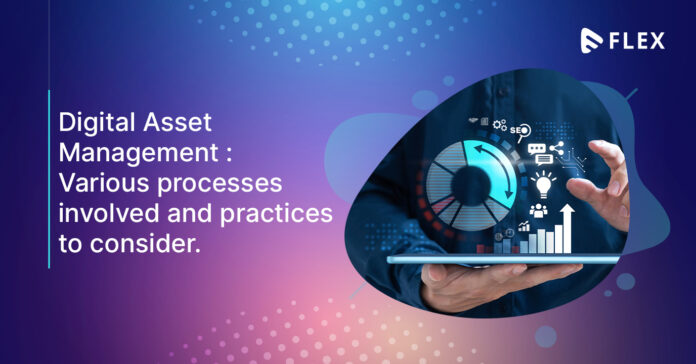Thousands of digital assets are held by businesses. Keeping track of all documents, spreadsheets, movies, logos, presentations, websites, and other items can be difficult. The sheer volume of data and the resulting need for effective storage, distribution, and retrieval is one of the primary reasons for implementing a digital asset management (DAM) platform.
Digital Asset Management (DAM) has become a big priority for digital marketers, especially in asset-heavy or highly regulated industries like retail, media, and healthcare, as a result of this pervasive side effect of content proliferation. Modern marketplace systems have become more technically powerful while also becoming more user-friendly, but transitioning to a DAM system still takes careful planning and preparation.
What is Digital asset management?
It is a systematic process of storing, maintaining, organizing, distributing, and retrieving your organization’s digital assets to fulfill your business objectives. Digital assets can be photographs, movies, statistics, brochures, or any other digital document, and these are referred to as assets, which can be reused. In general, these files exist in the same way that technology does, regardless of where they are kept and created on the device. As a result, the text or media is formatted into a binary source that grants permission to use it.
DAM is a metadata-driven solution that lets your company manage, enrich, and distribute digital assets from a centralized location. Powerful imports and exports, as well as powerful searches, are included in Digital Asset Management solutions.
Various process involved in DAM
The workflow of the DAM contains various steps involved in order to rightly allocate the digital assets and make them readily available for use at any point of time.
1.Content Creation
Data objects must first be introduced into the digital domain before a product can be created in the DAM system. Contents are encoded and decoded in order to prepare them for the storage.
Before that standardized file formats prepare these raw data, which makes it easy to retrieve the data.
2. Metadata allocation
Metadata is the information used to describe or classify an item in a Digital Asset Management library. This could be information regarding the asset’s color, image dimensions, audio or video time, or what it includes. DAM systems enhance the files with metadata
3. Indexing
It is the process of tagging your digital assets and organizing the assets in the media library. It is the act of giving each digital asset a distinct identity in order to make them more easily controllable, searchable, and retrievable. Each file’s metadata is added as part of the indexing process. Simply simply, metadata is data-related information. It is made of information that allows a file to be distinguished from the rest of the material. Its goal is to prioritize data alongside making your items easier to find.
4. Versioning
Versioning is a term that refers to a collection of tools that are used to manage changing information and track how digital assets have evolved over time. Simply put, it makes determining if someone is using the correct file at any given time much easier. DAM systems require versioning because it allows numerous iterations of documents and rich media to be created while keeping the original copy, which is beneficial to marketing departments.
5. Storing data
Simple cloud storage systems are not the same as digital asset management systems. Because the assets are easily searchable and findable via metadata, they enable companies to quickly locate and utilize digital assets. Second, DAM platforms usually allow material to be distributed downstream through other channels such as ecommerce websites, social media, and more.
6. Access Permission
Access control and user management are provided by the DAM system. Internal security is provided by every DAM system for your digital assets.
Internal and external stakeholders may discover what they need faster and focus on more critical activities with all digital content unified in one area. Similarly, various users can have varying access rights and permissions, ensuring that the correct individuals have access to the proper data.
7. Delivering
DAM gives us delivery tools so that we can send our content to the appropriate channels and clients. For a user, it’s a hassle-free experience. CDNs, or content delivery networks, are a common method of efficiently providing digital media assets to multiple output channels or directly to consumers.
8. Auditing
Internal audits should be done to assess DAM’s efficacy and identify areas for improvement. Regulatory organizations may also audit a DAM system to ensure that the technology and operations of a firm are compliant with legislation. In highly regulated areas like finance and healthcare, both types of audits are common.
How to choose a DAM
Before choosing your DAM first make sure what are your requirements. Once they are clear to you, now you can consider some of these practices before considering a DAM for handling your digital assets.
1. Adaptability
A DAM system must have the ability to adapt. Let’s say your system is built with.Net. As a result, your DAM should not request.Net compatible files for installation or any other activity in this situation. It must be capable of supporting any language.
2. Scalability
The more crucial thing is to have a centralized media library that is easy to access as your organization grows. So think about the future and choose a DAM system that will last for years. Ensure that it has the facility to expand its storage capacity at ease in case of need.
3. Quality of the search result
If a DAM system is unable to locate your digital assets, it is deemed a failure. You should constantly seek searching and indexing capabilities when picking a DAM tool. A DAM system must be adaptable and accommodate a variety of metadata methods. This will enable you to make a variety of changes to your media file.
4. Integration
With precision, ease, and simplicity, management delivers visibility into all of your organization’s assets. You may easily report on assets for purposes of inventory, compliance, and auditing. The ideal DAM solution connects with other business solutions, such as asset generation and distribution, as well as any future systems you want to implement. Look if your DAM is compatible with other tools.
5. Analytics Features
Analytics is one of the overwhelming and crucial features in any data management system. It helps you to track the activities related to your digital asset such as client profiling, user location, asset usability status etc. A decent analytics feature will cover all of the information about your projects down to the smallest aspect.
Conclusion
Major ott platform providers have relied on DAM systems to manage their digital assets for years. Now that digital asset management systems are more customisable and offer a wider choice of costs and features, it’s time to consider; whether your DAM is up to the task? Your files are only valuable if you can use them effectively.
With Muvi Flex as your DAM partner, you can distribute your digital assets to your users, manage them, and evaluate their performance. The most sophisticated CMS allows you to simply upload, store, download, and distribute assets. Traditional methods of sharing assets with your partners or end users, like ZIP files, email transfers, and insecure file transfer protocols, are no longer used. You can easily embed the material into your website and apps using Muvi Flex and maintain total control over them. Take a free trial today and explore more about the features provided by Muvi. Muvi believes it is a best practice to test a product before buying.































